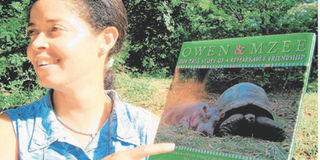Kenyan hated by poachers but loved by animals feted

Dr Paula Kahumbu, executive director of Kenya Land Conservation Trust and WildlifeDirect, with her children’s book that has been translated into 27 languages. She won this year’s National Geographic Annual Award.
A Kenyan who has saved hundreds of lions, vultures and birds from poisoning became Africa’s top conservationist when she won the prestigious National Geographic Annual Award.
“The award is the greatest accolade I have ever received for my work,” an elated Dr Paula Kahumbu the executive director of the Kenya Land Conservation Trust and WildlifeDirect said on learning of the award on Thursday.
The environmentalist, hated by poachers and loved by elephants for her fight against ivory poaching will today briefly break her quest to protect wildlife and travel to Washington to receive her award and $25,000 (Sh2.2 million) at a ceremony to be held on Tuesday.
Born and raised in Nairobi, she was mentored into the wild life care by the well-known conservationist Richard Leakey during the 1980s when elephants were being hounded in every corner of the country for their ivory.
With fervour, fellow conservationists say, she has been most vocal against poaching and calls to renew international trade in ivory.
“One of my happiest days in life was July 18, 1989 when some 12 tonnes of ivory were set ablaze by former president Moi at the Nairobi National Park. What an international statement!” she told the Nation on Thursday.
She is one of Kenya’s top bloggers and tweeters, and through WildlifeDirect, she has created Africa’s largest wildlife blogging platform that tells stories from the field. If anyone wants the latest in conservation frontline that explain issues like the ivory trade, poaching, and human-wildlife conflict through real-life stories, she may be the blogger to follow.
“This award is about all of us; the conservation community in Africa,” says Dr Kahumbu who plans to raise one million dollars for her projects.
Although she is involved in many conservation fronts, it is the fight against the chemical Furadan that brings out the fighter in her. Manufactured in US, Furadan, a highly poisonous insecticide but banned for use there, is readily available in Kenya for crop protection.
However it has been used to poison animals where there are wildlife-human conflict. When lions attack, for example, livestock herders have been know to poison the cats.
According to Dr Kahumbu, Kenya’s lions have been reduced to fewer than 2,000, and vultures are down by 50 to 80 per cent over the last 10 years due to poisoning as they scavenge on carcasses of livestock laced with the deadly product, as well as the flesh of the victims of the product.
The problem is much bigger than this, however. “What we are witnessing in the poisoning of lions and vultures across Kenya is shocking, but it is just the tip of the iceberg,” Dr Kahumbu says.
Nairobi Park
But she has yet another fight in her hands over the survival of the Nairobi National Park whose worth to the city she can only equate to the State Empire building in the US.
Environmentalists have presented a strong case indicating that the park will be irreparably strangled if the proposed Greater Southern Bypass is built.
“This will destroy the city’s most valuable asset and we are asking Roads ministry to ensure any development considers the needs of wildlife and people so Nairobi continues to be the Worlds Greatest City Game Park.”
The bypass is expected to link Mombasa highway with Nairobi-Narok-Bomet-Kisii highway, from Lukenya through Kitengela, Ongata Rongai and Ngong where it will branch into two: one to Rironi, another up to Suswa.
Dr Kahumbu is also the author of the children’s book about a baby hippopotamus that was adopted by a giant tortoise. Over one million copies of Owen and Mzee have been sold and has since been translated in 27 languages including Japanese, Spanish, French, German, Czech, Chinese and Kiswahili (translated and locally published by The Jomo Kenyatta Foundation).




